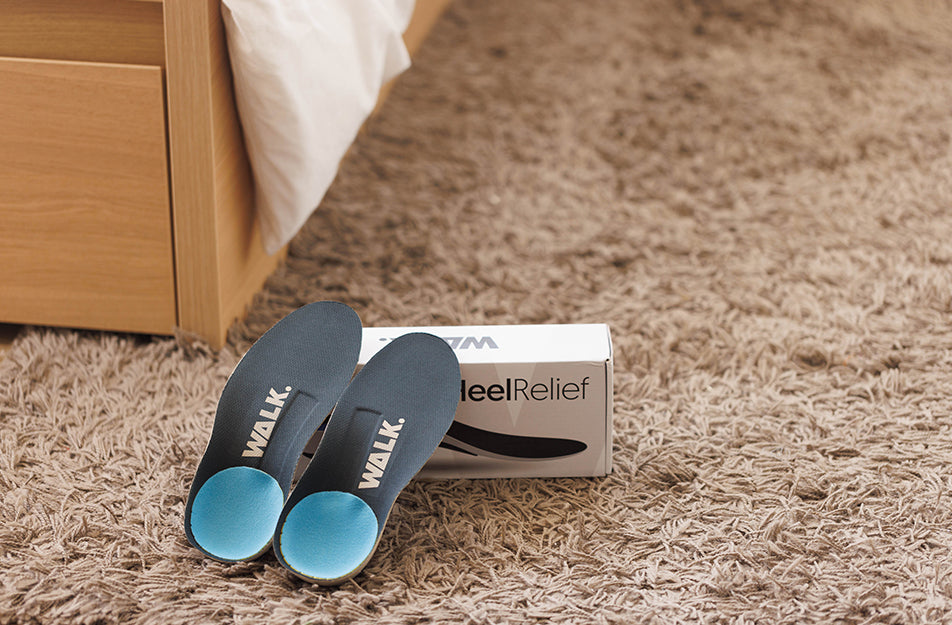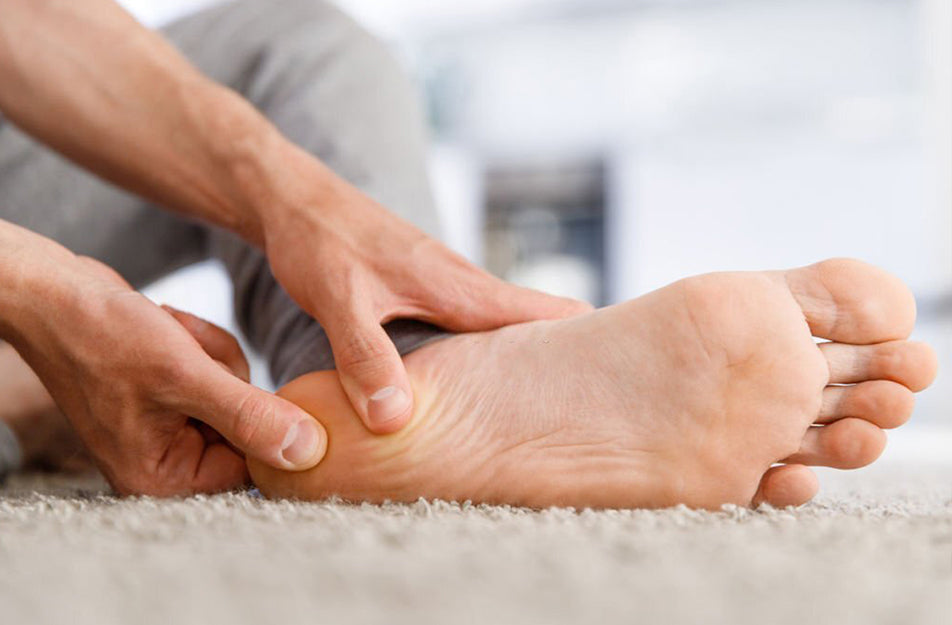What Is Plantar Fasciitis?
Plantar Fasciitis is simply the inflammation of a tendon in your foot. Specifically, the Plantar Fascia, which is a cord of thick, strong and flexible tissue. This tendon is present in both the feet and serves to connect the heel bone to the bones in the toes, and therefore helps with foot movement.
The condition plantar fasciitis presents as stabbing pain in the sole of your foot, usually involving the heel area. It starts early in the morning as you take your first steps. However, with time and increased activity, it tends to fade away during the rest of the day. But it is prone to return if your day involves long periods of standing. This condition also has a predisposition for a certain kind of population which includes people suffering from obesity and runners.
Causes Of Plantar Fasciitis
There are a number of factors responsible for plantar fasciitis. The Plantar Fascia tendon is responsible for a very persistent task, which is to support your foot as you walk and absorb the shock waves with every step you take. This means it is consistently under a large amount of stress and tension. This can cause the tendon to become overworked and give way to signs of wear and tear.
Repeatedly using any tendon in the body can cause small tears to appear in its tissue. Tearing of the tissue causes inflammation which is the main process that causes pain and irritation.
Some other factors that contribute to plantar fasciitis include the wrong type of shoes, inappropriate walking surfaces and sometimes even the foot structure.
Risk Factors for Plantar Fasciitis
Certain groups of people are more prone to suffering from Plantar Fasciitis than others. These people may suffer from several flares of plantar Fasciitis during their lifetime. Some important risk factors include:
- Age – Plantar fasciitis is common in older adults as they have been using their feet more often over their lifetime. The mean age group for this condition is 40-60 years.
- Selected Physical Activities – Not all physical activity will aggravate the plantar fascia, only the activities that require the maximum usage of the heel and its tissue lead to plantar fasciitis. For example, aerobic dancing, ballet, and marathon running.
- Foot Mechanics – Some people suffer from anatomical misplacement within their feet. These conditions are usually genetic like Flat foot or high arches. These minor changes in anatomy can cause the weight distribution in your foot to change which, of course, leads to an imbalance in stress all over the foot. This can also cause plantar fasciitis.
- Obesity – The overall weight also has an effect on the plantar fascia, more weight causes more stress on the tendon causing it to work harder, which is why obese people may suffer from Plantar Fasciitis from an early age.
- Occupations That Keep You on Your Feet – Another reason for increased stress and tension on your foot is jobs that require long hours of standing or standing on uneven, hard surfaces. For example, guards, teachers and factory workers.
Complications Of Plantar Fasciitis
Complications accompany any medical condition that goes untreated for too long. It is the same in this condition, if plantar fasciitis is not treated at the right time, it may start to cause chronic heel pain that may lead you to alter your daily routine because of the severe pain.
You may even start to notice a shift in the way you walk and stand, you may start feeling pain in other joints of your body too, like your spine, hips, and knees.
Treatment For Plantar Fasciitis
The treatment for Plantar Fasciitis can be simple, it only depends on whether you decide to treat it early on or ignore it until it turns into a chronic condition. If treatment is started early in the disease progression, it usually consists of conservative measures with many not even requiring a doctor’s visit.
Conservative treatment includes frequent icing, practising certain stretches before you start your day, changing the way you walk and modifying your daily activities. These few measures can lead up to a successful recovery within months. Therefore, it is a curable condition.
- Medicine
Pharmaceutical medicines play an insignificant and temporary role in the treatment of Plantar Fasciitis. NSAIDs such as Advil, Paracetamol and Naproxen Sodium are given for temporarily relieving pain. However, they have no long-term benefit and may cause you to ignore your condition for too long.
· Physical Therapy and Therapy Devices
Physical therapy and therapy devices are a great way to ease your symptoms. Therapy not only relieves the pain within a few sessions but helps your foot adapt to a more comfortable position which leads to less stress on your plantar fascia. Examples include:
- Physical Therapy – A physical therapist can show you easy exercises that strengthen other muscles involved in walking and standing so that your plantar fascia is less burdened. Some stretches they recommend may even lengthen your plantar fascia so that it is not inflamed by routine activities.
- Therapeutic Devices – This includes a wide variety of support devices worn at different times that may assist your foot during times of activity and rest.
For example, the application of athletic tape supports the sole of your foot during daily activity. A device called a night splint is worn overnight, it is responsible for stretching the plantar fasciitis which lengthens it and allows it to work easily during times of activity.
Additionally, orthotics are devices you can place within your shoe such as an insole during times of activity. This is a great method to combat the development of plantar fasciitis at all. It is the best option for people who are already suffering from other conditions of the foot such as a flat foot. The orthotic can give your foot a normal shape which redistributes weight causing relief in the plantar fasciitis.
- Walking Support – Another method may include walking support like boots, crutches or canes. This is usually temporary and is given only in cases of severe pain. They help by taking stress off the foot completely as you can shift your weight onto the crutch instead of your foot. This in turn allows your plantar fascia to heal and also keeps you pain-free.
- Surgery
Surgery is only performed as a last resort treatment for people who feel the methods stated above have been unhelpful even after prolonged use.
Surgery may involve a simple steroid injection which acts as a temporary pain reliever by relieving the inflammation. They are great for immediate pain relief; however, their constant use may cause the plantar fascia to weaken and tear completely over time.
A recently developed surgical procedure includes extracorporeal shock wave therapy. This method is still under trial and is not a proven treatment for plantar fasciitis, which is why it is reserved for chronic sufferers who were unable to benefit from any other therapy. It involves the direct application of sound waves to the painful area of the foot.
Another last resort option includes surgery which severs the tendon completely. Therefore, it no longer stretches from the toes to the heel. This is only given due to severe pain, not relieved by any other intervention.
Prevention Of Plantar Fasciitis
Plantar fasciitis is a preventable condition, here are some steps you can take to avoid it:
- Maintain A Normal BMI – Make sure you are within the right weight range for your height, as overweight and obese people are more likely to suffer from plantar fasciitis because of increased stress on the plantar fascia.
- Choose The Right Shoes – Choosing comfortable and medically fit walking shoes is important to maintain good weight distribution for your foot. Shoes with a moderate heel, soft, thick soles, and good support for the arch are the right kind of choice. Make sure you wear shoes like flats or heels only for short periods of time.
- Choose The Right Running Shoes – Make sure to pick the right training shoes for your sport of choice, all sports involve different kinds of stresses on various parts of the foot which is why the right training shoes can make all the difference in the world. Additionally, make sure to replace your shoes once they are worn out.
- Change Your Activities – Once you realise you might be suffering from plantar fasciitis, you should avoid doing strenuous sports and opt for activities like jogging or swimming instead.
- Ice Your Foot – Icing is clinically proven to reduce inflammation in both muscles and tendons; therefore, it is a good pain reliever. You can apply ice for 15 minutes at a time, 3-4 times a day.




